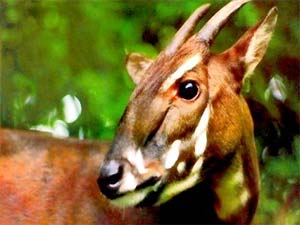Establishing 2 saola reserves in Central Truong Son.
On September 28, the People's Committee of Thua Thien Hue and Quang Nam provinces signed a commitment to preserve the saola species. Accordingly, two new protected areas, one in Thua Thien Hue and one in Quang Nam, were established.
On September 28 in Hoi An, Quang Nam, the Central Truong Son Landscape Conservation Program organized a Scientific Workshop on the Conservation of Saola (scientific name is Pseudoryx nghetinhensis.
The Central Truong Son is a newly established protected area that offers a chance to survive for saola, a newly discovered animal that is at an extremely dangerous level.
A series of activities on the conservation of this rare animal will be approved in Quang Nam and Thua Thien Hue provinces, to ensure the survival of this animal in Vietnam after 20 years since This species was discovered.

Saola - an animal that needs strict protection.(Photo: Vu Trung)
In this conservation program, the People's Committee of Thua Thien Hue and Quang Nam provinces signed a commitment to preserve the saola, including ten application action points for each province. In this commitment, two new protected areas, one in Thua Thien Hue and one in Quang Nam, have been announced.
Each reserve has an area of 121 km 2 . These are two newly established saola reserves located close to each other with an expansion area of 165 km 2 connecting these two protected areas with Bach Ma National Park with a width of 220 km 2 .
Thus, a conservation area with a total area of 2,920 km 2 has been formed continuously from the Vietnamese coast to the Xe Sap National Biodiversity Conservation Area in Laos. This is a natural corridor less affected by development, climate change, and human impacts.
The establishment of three additional zones in the network of protected areas in Vietnam has created a safe living area essential for saola. In addition, it is also home to a number of endangered endemic animals such as Truong Son, five-colored langurs, white-cheeked crested gibbons, and many other newly discovered and unpublished species.
Hunting, which is a very common situation in the saola region, is the main cause of the extinction of saola. According to a study conducted by WWF in the past year, the number of saola has decreased rapidly since the type of noose trap appeared in the mid-90s.
Hunting is caused by the need to consume wild animal meat in developed urban centers like Hanoi and Ho Chi Minh City. Hundreds of snare traps at a time and hunting dogs are also a major threat to Saola, as this species almost does not have a defensive response to dogs.
Saola is the first large mammal in the world to be discovered since 1936. Saola only inhabits the Truong Son mountain range of Vietnam and Laos, particularly in areas of 6 provinces. in Vietnam and 4 provinces in Laos.
Although there is little information about Saola species at present, the total number of saola worldwide is estimated to be no more than 250 and in fact may be much lower. Moreover, Sao la is divided in nine scattered sub-population of la sa, in which the largest population lives in the southern region of the distribution range of this species, located in the middle border Thua Thien Hue and Quang Nam provinces.
Vu Trung
- Establish saola conservation area in Thua Thien Hue
- Unexpectedly discovered saola in Vietnam after 15 years of absence
- Discovering new species in Truong Son mountain range
- Saola storms hit Taiwan, 6 people were killed
- Biodiversity conservation in Central Truong Son
- The mystery of the saola species
- 53 Filipinos died of Saola
- Central people struggle in flooding
- Euro 1.7 million to build saola conservation area
- The most gold reserves in the world
- Sao la is captured in Laos
- Save the la star
 Animal 'suffering' after hibernation
Animal 'suffering' after hibernation Why do goats climb well?
Why do goats climb well? Scientists were surprised to see chimpanzees eating turtles
Scientists were surprised to see chimpanzees eating turtles Giant catfish died deadly due to drought in Thailand
Giant catfish died deadly due to drought in Thailand